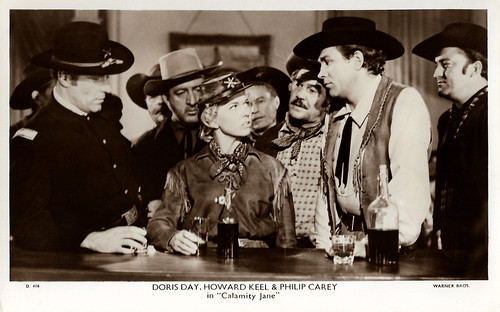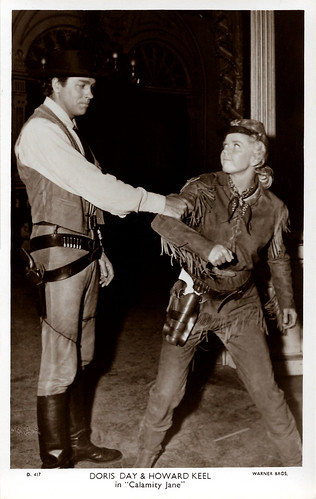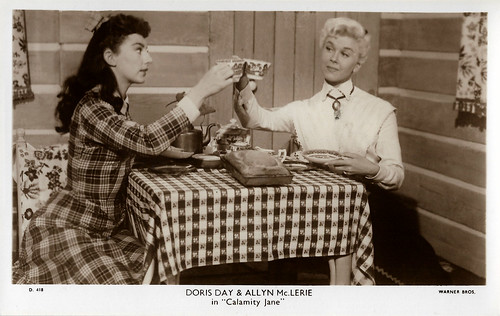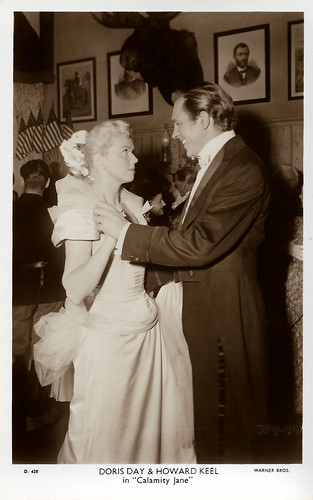
American postcard by AZUSA Publishing, Inc., Englewood, Colorado, no. 604, 1994. Caption: Calamity Jane, Martha Jane Canary Burke, Frontierswoman (1852-1903). Expert with a horse and rifle, and often clad in men's clothes, Jane warned that to offend her was to court calamity. She was associated with the 7th Cavalry and scouted for Lt. Colonel George Custer. During the 1880s, Jane travelled with several Wild West Shows. She enjoyed men and alcohol and led a rip-roaring life from Kansas to Montana.

French poster postcard by Editions F. Nugeron, Levallois Perret, no. E 34. Belgian poster by Paramount. Gary Cooper and Jean Arthur in The Plainsman (Cecil B. DeMille, 1936).

British postcard in the Picturegoer Series, London, no. D. 416. Photo: Warner Bros. Philip Carey, Doris Day and Howard Keel in Calamity Jane (David Butler, 1953).
I baptise you Calamity Jane, heroine of the plains
Martha Jane Cannary was born near Princeton, Missouri. She was the eldest of six children born to farmer Robert W. Cannary and Charlotte M. Cannary, née Burge. Some sources mention 1852 as her birth year, but he first confirmed record of Martha was in the 1860 US census, in which the Missouri authorities recorded her as being four years old, which gives 1856 as her year of birth. Her Mormon family lived in poverty on a farm with poor soil and a bad reputation. Her father was a compulsive gambler, and her 15-year-younger mother, a flamboyant character who drank, smoked cigars and swore freely, and had affairs with other men. As a child, Marta loved to play outside and learned to ride horses at an early age, soon managing to train even the most stubborn ones.
The family was crippled by debt and received a court summons before March 1863, so they decided to sell their 180 acres of land for a pittance on 20 December 1862 and leave Missouri to escape prosecution. Her parents took her on a wagon train to Montana, travelling along the Oregon Trail. During the five-month journey, she took part in hunting with the men. Along the way, her mother, Charlotte, died of pneumonia in Blackfoot, Montana. Soon after arriving in Virginia City, the family moved on to Salt Lake City in the spring of 1866, reaching it in the summer. Her father disappeared in 1868, and no one knew whether he had died or left to start a new life elsewhere. Martha Jane protected her younger siblings and tried to keep the family afloat. She loaded their wagon and took the family to Fort Bridger, Wyoming Territory, where they arrived in May 1868. From there, they travelled on the Union Pacific Railroad to Piedmont, Wyoming. In Piedmont, Jane took whatever jobs she could find to provide for her large family.
From 1870 onwards, Martha began the adventurous life that would make her famous. She travelled through the western states of the United States dressed as a man and took on odd jobs. She was a stagecoach driver, saloon girl, nurse, and gold miner. In 1872, she became a scout for General Custer's troops. She later said that she was involved in several campaigns in Arizona in a long series of conflicts with the Native Americans. She began to wear men's clothing, carried out dangerous missions, and became a skilled markswoman. According to her memoirs, it was during her time as a scout that she earned the nickname ‘Calamity Jane’. Hired by General George Crook, she was ordered to leave with a detachment for Wyoming. After several days on the road, the group of soldiers encountered several Native American skirmishes, during which six soldiers were killed and many others seriously wounded. On their way back to the fort, just a few kilometres away, the detachment was ambushed. The captain was wounded. Turning around, Martha saw that the officer was about to fall from his horse. She galloped towards him and caught him before he fell. She hoisted him onto her horse, in front of her, and brought him back to the fort, saving his life. Once he had recovered, the captain jokingly said to her, ‘I baptise you Calamity Jane, heroine of the plains.’ This nickname would stay with her for the rest of her life. 'Captain Jack' Crawford served under General George Crook, and according to the Montana Anaconda Standard (19 April 1904), he stated that Calamity Jane "never saw service in any capacity under either General Crook or General Miles".
Calamity Jane knew how to command respect among the men of the Wild West: she smoked, drank, chewed tobacco and swore. She soon became a legend. In 1875, she took part in the geological expedition led by Professor Walter Jenney, the Black Hills Expedition, and it was on this occasion that Calamity Jane appeared in the press. She then had to join General Custer at the Little Bighorn. During her journey, she was forced to swim across the Platte River, after which she fell ill. She was repatriated to Fort Fetterman, where she remained for fourteen days. Then, having recovered, she set off for Fort Laramie. There, she met revolver shooter Wild Bill Hickok. She travelled with him to Deadwood and then acted as a courier between Custer, still in the Black Hills, and Deadwood. In 1876, her friend Wild Bill Hickok was shot in the back of the head by Jack McCall during a poker game at Saloon No. 10 in Deadwood. She claimed in her biography that she was married to Hickok before 1876 and that he was the father of her child, Jean Hickok McCormick (1873). According to French Wikipedia, the father of her daughter was a lieutenant with whom she had had a brief affair. The girl was given up for adoption.
To this day, it remains unclear whether Calamity Jane herself spread certain stories about details of her life or whether they correspond to reality. She left Deadwood in 1877 with the Seventh Cavalry Regiment. The following year, she did some prospecting. She then travelled between different forts and towns, driving a team of oxen, the most resilient animals for this type of journey in this particular region. She constantly changed jobs. In 1878, she nursed victims of a smallpox epidemic in the Dakota area. In 1881, she purchased a farm near Yellowstone Park, where she ran an inn for a short time. She also worked as a laundry maid in brothels run by her friend Dora DuFran. In 1887, she married Clinton Burke after having lived with him for several years. They moved to Boulder, where she tried her hand at being an innkeeper again. In 1887, she had a daughter, Jane, whom she gave up to foster parents after her husband had left her.

British postcard in the Picturegoer Series, London, no. D 417. Photo: Warner Bros. Doris Day and Howard Keel in Calamity Jane (David Butler, 1953).

French postcard in the Picturegoer Series, London, no. D. 418. Photo: Warner Bros. Allyn McLerie and Doris Day in Calamity Jane (David Butler, 1953).
Poor, blind, alcoholic, but still as famous as ever
Calamity Jane took part in several shows centred on the myth of the American West, which were popular at the time. From 1893 onwards, she appeared in Fred N. Cummings' Wild West Show as a stunt rider in the role of ‘Indian killer’. After that, she toured with other shows, including Buffalo Bill's popular show, Buffalo Bill's Wild West. In 1896, she was hired by the Dime Museum of the Kohl & Middleton Circus in Chicago and Minneapolis, which she took advantage of to publish her autobiography. This was a small brochure full of inaccuracies and invented heroic deeds. As Calamity Jane was considered virtually illiterate, it is likely that she dictated this short text or that it was written by the show's organiser. She never stayed in one place for long and often got into arguments with her employers. In 1901, she was committed to a poorhouse. A New York journalist came to fetch her to take part in the Pan-American Exposition in Buffalo. By this time, she was already an alcoholic and unmanageable, and she was quickly dismissed.
In 1903, Calamity Jane died alone of pneumonia in a hotel room in Terry, a small mining village near Deadwood, of pneumonia. She was poor, blind, alcoholic, but still as famous as ever. A bundle of letters to her daughter, which she had never sent, was allegedly found among her belongings. However, their authenticity is doubted. Two of her friends transported her body to Deadwood, where members of the Black Hills Pioneer Society organised a prestigious funeral. Dressed in white and laid in a padded coffin, her body was displayed in the back room of a saloon, where all the inhabitants of Deadwood could come and pay their last respects. She was buried in Mount Moriah Cemetery in Deadwood, next to Wild Bill Hickok, in accordance with her wishes. Her grave still exists today.
Her adventurous habits, alcoholism and rough lifestyle made her a sensational and mysterious example for many independently minded women of her time. Several films have been made about her life. Already in the silent era, several films were made about her, such as My Old Kentucky Home (Ray C. Smallwood, 1922) with Lucy Fox. Jean Arthur played Calamity Jane in The Plainsman (Cecil B. DeMille, 1936) opposite Gary Cooper. Jane Russell played her in the comedy The Paleface (Norman Z. McLeod, 1948) with Bob Hope, Yvonne De Carlo in Calamity Jane and Sam Bass (George Sherman, 1949) and Evelyn Ankers in The Texan Meets Calamity Jane (Ande Lamb, 1950).
The best known film is the musical Western Calamity Jane (David Butler, 1953) starring Doris Day as Jane and Howard Keel as Wild Bill Hickok. The plot of the film is almost entirely fictional and bears little resemblance to the actual lives of the protagonists. The film won the Best Song Oscar for 'Secret Love', by Sammy Fain and Paul Francis Webster. Ma Cortes at IMDb: "In one of her best Warner Bros musicals, Day splendidly stars as the gun-toting, rip-snorting Calamity Jane of Western lore. It packs one of the best soundtracks ever written for the screen. As Doris Day stands out singing marvellous songs such as 'Whipecrack a way', (...). She is accompanied by a cast of plenty of Hollywood stalwarts, including Allyn Ann McLerie as Katie Brown, Philip Carey, Dick Wesson, Paul Harvey and Chubby Johnson. This breeze-fresh movie filled with get-up-and-go was well directed by David Butler." A musical based on this film followed in 1961. In Wild Bill (Walter Hill, 1995), Calamity Jane was portrayed by Ellen Barkin, and in the Western TV miniseries Buffalo Girls (Rod Hardy, 1995), she was played by Anjelica Huston.
The TV movie Calamity Jane (James Goldston, 1984) featured her life story, including her alleged marriage to Wild Bill Hickok and the daughter she purportedly gave for adoption. British actress Jane Alexander portrayed Calamity and was nominated for an Emmy in 1985 for Outstanding Lead Actress in a Limited Series or Special. Calamity Jane is also one of the prominent characters in the series Deadwood (2004–2006). Robin Weigert played Calamity Jane in the series and in the HBO sequel Deadwood: The Movie (Daniel Minahan, 2019). Calamity Jane also plays a leading role in the Lucky Luke comic strips: 'Calamity Jane' (1967), written by René Goscinny and illustrated by Morris. In the French film Lucky Luke (James Huth, 1995), Jane was portrayed by Sylvie Testud. In 2020, the animated film Calamity (Rémi Chayé, 2020) was released, about the youth of Calamity Jane. This film won awards at the prestigious Annecy International Animation Film Festival and at Cinekid in the Netherlands.

French postcard in the Picturegoer Series, London, no. D 419. Photo: Warner Bros. Doris Day in Calamity Jane (David Butler, 1953).

British postcard in the Picturegoer Series, London, no. D 420. Photo: Warner Bros. Doris Day and Howard Keel in Calamity Jane (David Butler, 1953).

British postcard in the Picturegoer Series, London, no. D 421. Photo: Warner Bros. Doris Day and Howard Keel in Calamity Jane (David Butler, 1953).
Sources: Ma Cortes (IMDb), Wikipedia (Dutch, German, French and English), and IMDb.
No comments:
Post a Comment